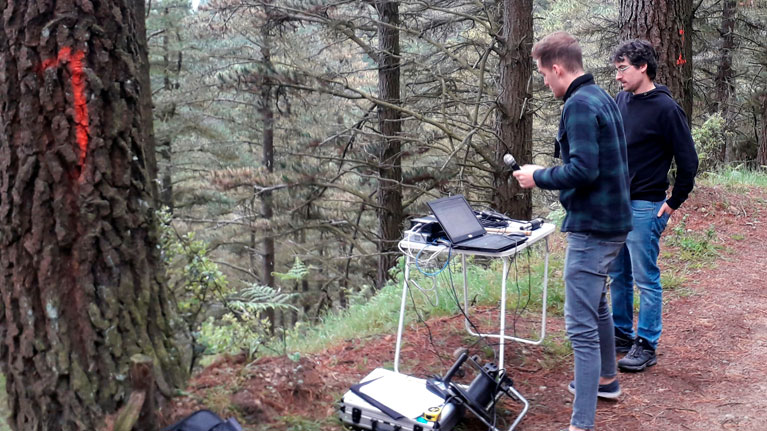A technological innovation “to listen” to tree diseases
The Tekniker technology centre is developing a percussion-based method to ascertain the extent to which pine trees are diseased based on changes in the sounds they make. This technology could help to evaluate potential wood plagues more effectively and objectively.

From simple thermometers to advanced data analysis techniques, medical technology provides numerous tools with which the severity and propagation of diseases affecting human beings and animals can be determined. Although when a disease affects the vegetable kingdom, there are less technologies available and the technique most frequently used to determine tree health tree is based on evaluating its physical appearance.
It is in this context that the Tekniker technology centre, a member of the Basque Research and Technology Alliance (BRTA), has developed a percussion-based method to detect diseases in trees by using the basic principle of biomimetics, a science that mimics nature: compared to a healthy tree, diseased trees make different sounds when percussion is applied.
“Measuring the frequency of sound in trees is similar to measuring body temperature in human beings”, explains Jon Ander Sarasua, a Tekniker researcher.
Tekniker has developed this technology jointly with BASOEKIN within the framework of the Persefone project (Development of a percussion sensor for wood disease evaluation), under the European collaboration programme ATTRACT, led by the European Organisation for Nuclear Research Nuclear (CERN) and the Esade business school and has received investments from the European Commission’s Horizon 2020 programme.
More specifically, the technology developed by Tekniker features a percussion device consisting in a hammer and a signal data acquisition system equipped with a microphone to obtain a quick, simple and economical diagnosis of how severely trees are affected by brown band, also known as pine tree plague.
This technology will enable pine forest managers to carry out highly effective assessments of potential wood plagues and take the necessary steps as this disease constitutes a hazard for plantations of common species in the north of Spain such as radiata pine trees.
“Diseased trees lose water. And when that happens, the sound they produce also changes. Just like when a guitar becomes dehydrated and the sound of the notes it produces changes”, says the researcher.
This ground breaking idea stems from a basic mechanical principle: tree density diminishes whenever water is lost. Consequently, and when percussion is applied, trees produce a sharper sound (also called acoustic response). If a tree is healthy, however, it will grow and make uniform or dull sounds.
“Although the human ear cannot distinguish between these variations nor quantify them, you only have to use a data processing system equipped with a microphone to do so”, says the researcher.
Subsequent recordings
Step one of this project consisted in carrying out a feasibility study with the equipment to detect vibration peaks. In order to achieve this goal, the sensor was validated with accelerometer measurements. Next, the sensitivity of changes in different vibration modes was evaluated by means of FEM (Finite Element Method) simulations as well as experimentally at a laboratory level.
Finally, an experimental study was carried out in a real environment. The evolution of natural frequency readings found in ten pine trees was studied for eight months.
Researchers from the two organisations in charge of this initiative, Tekniker and BASOEKIN, visited the same pine tree forest affected by brown band on a monthly basis to compile information on the sound produced by trees whenever percussion was used. Sound frequency trends found in subsequent recordings allowed these researchers to get an overall view of the extent to which these forests were diseased. They also performed visual assessments to establish their degree of severity.
“In the same way that BASOEKIN specialists performed visual inspections on trees, we at Tekniker measured the disease itself with objective data supplied by sound”, adds Jon Ander Sarasua.
In the course of the study it was noted that some of the trees that died during the study period behaved randomly and changed their natural frequency as a consequence of weather conditions; trees that were still alive, however, followed a trend that was very similar to the experts’ visual assessment. In fact, evidence showed a slight delay between the results supplied by the sensor and the marks made by the experts.
Consequently, it was demonstrated that by measuring a tree’s main natural frequency it is possible to determine its future condition even before any visual symptoms appear. This conclusion should allow experts and landowners to detect diseases in the early stages and apply treatments quickly to fight against the pathogen.
This project has an impact on SDG 15 - Life on land, contributing towards the environmental pillar of sustainable development, and, ultimately, on society at large.
This Project has received funding from the European´s Union Horizon 2020 Research and Innovation programme under ATTRACT Project, GA nº777222
